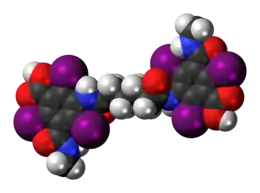Iocarmic acid
 | |
 | |
| Clinical data | |
|---|---|
| Trade names | Dimer-X |
| Other names | 3-[[6-[[3-Carboxy-2,4,6-triiodo-5-(methylcarbamoyl)phenyl]amino]-6-oxohexanoyl]amino]-2,4,6-triiodo-5-(methylcarbamoyl)benzoic acid |
| ATC code | |
| Identifiers | |
IUPAC name
| |
| CAS Number | |
| PubChem CID | |
| DrugBank | |
| ChemSpider | |
| UNII | |
| KEGG | |
| CompTox Dashboard (EPA) | |
| ECHA InfoCard | 100.030.771 |
| Chemical and physical data | |
| Formula | C24H20I6N4O8 |
| Molar mass | 1253.871 g·mol−1 |
| 3D model (JSmol) | |
SMILES
| |
InChI
| |
| | |
Iocarmic acid (trade name Dimer-X) is a pharmaceutical drug used as an iodinated contrast medium for X-ray imaging in the 1970s and 80s. Uses included imaging of the uterus and Fallopian tubes. It was applied in form of its salt, meglumine iocarmate.[1][2]
It is not known to be marketed anywhere in the world in 2021.
References
- ↑ Schütte HE (1982). "Comparative study: Endografine (diatrizoate), Vasurix polyvidone (acetrizoate), Dimer-X (iocarmate) and Hexabrix (ioxaglate) in hysterosalpingography". Diagnostic Imaging. 51 (6): 277–83. PMID 7173007.
- ↑ Van Dellen JR, Lipschitz R (October 1973). "Meglumine iocarmate (Dimer-X) ventriculography". Clinical Radiology. 24 (4): 449–52. doi:10.1016/s0009-9260(73)80146-1. PMID 4621055.
This article is issued from Offline. The text is licensed under Creative Commons - Attribution - Sharealike. Additional terms may apply for the media files.